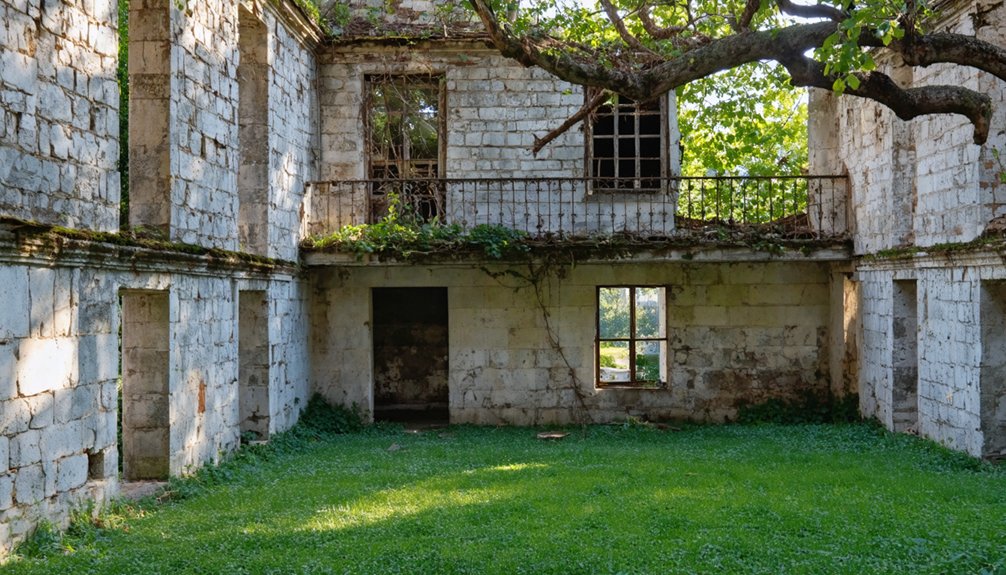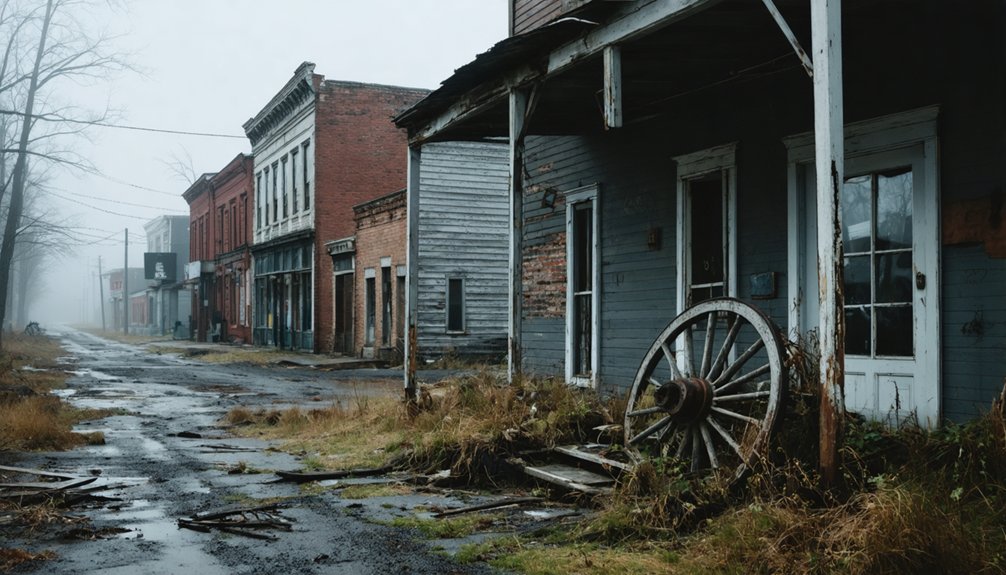Colonial ghost town remnants are abandoned settlements featuring preserved colonial architecture, visible infrastructure, and historical significance. You’ll find over 1,500 in British Columbia alone, with many others distributed across resource-rich regions in Africa and North America. These sites are documented through integrated research methods including archival records, field surveys, GIS mapping, and LiDAR. Modern database systems track approximately 4,531 ghost towns with unique identifiers, classification systems, and preservation statuses. The following analysis reveals their complex stories.
Key Takeaways
- Relational databases with unique identifiers track approximately 4,531 ghost towns across the United States.
- Database cataloging follows a systematic process: archival research, GIS mapping, and field verification.
- Sites are classified by abandonment level, settlement type, and preservation status for comprehensive documentation.
- Digital mapping innovations like georeferencing and ArcGIS Pro enable detailed visualization of historical settlements.
- Rigorous metadata management ensures traceability through careful source tracking and regular database updates.
Defining Colonial Ghost Towns: Key Characteristics and Global Distribution

Colonial ghost towns represent a fascinating category of abandoned settlements characterized by substantial visible remnants of their once-thriving existence.
You’ll recognize these sites by their abandoned colonial architecture, preserved infrastructure like roads and foundations, and the absence of viable economic activity. To qualify as a ghost town, tangible remains must persist—from dilapidated main streets to town cemeteries—serving as physical markers of cultural heritage.
These abandoned communities exist on every continent, though they’re particularly concentrated in resource-rich regions of Africa and North America. Many of these sites have become popular destinations for heritage tourism that celebrates their historical significance. WikiProject Ghost towns welcomes participation from editors interested in improving coverage of these historical sites worldwide.
British Columbia alone houses over 1,500 ghost towns. Classification systems differentiate between completely uninhabited settlements (Class C) and those with dramatically reduced populations.
What defines these places ultimately is that “the reason for being no longer exists”—whether through resource depletion, transportation shifts, or government actions.
Documenting the Lost Settlements: Research Methodologies and Approaches
To effectively document colonial ghost towns, you’ll need to synthesize archival records such as land titles, census data, and historical newspapers with systematic field survey techniques that identify structural remains and artifact distributions.
Your research methodology should incorporate digital mapping innovations, particularly GIS and LiDAR technologies, which allow for precise spatial analysis and visualization of settlement patterns obscured by time.
These integrated approaches enable you to triangulate evidence across disciplines, revealing not only physical layouts but also the socioeconomic dynamics that contributed to these settlements’ eventual abandonment.
The State Archives in Tallahassee provides valuable resources for ghost town research without requiring special permissions or appointments for access.
Integrating Archival Records
While searching for traces of vanished colonial settlements, researchers must integrate diverse archival materials to reconstruct lost communities with methodological rigor. You’ll encounter archival challenges when triangulating property records, historical maps, and colonial documentation to establish spatial locations of ghost towns. Even with limited evidence—just three to five named residents associated with a specific place—you can determine geographical positioning.
Colonial archives present silences where marginalized voices should be, as settler narratives often engulf indigenous perspectives. These community narratives emerge through careful integration of archaeological findings with documentary evidence, revealing resistance beneath European architectural veneers. Effigy censers discovered in elite Maya homes provide tangible evidence of traditional practices persisting despite Spanish colonial pressures. Thousands of valuable Oaxacan documents exist in Mexican archives and foreign institutions, offering crucial insights into settlements that have disappeared from the landscape.
Field Survey Techniques
Five fundamental field survey techniques form the backbone of colonial ghost town investigations, each offering distinct advantages in documenting ephemeral settlement remains.
You’ll find pedestrian survey most efficient for initial site assessment, as teams systematically walk gridded areas to identify surface artifacts.
Shovel testing reveals subsurface deposits through standardized pits at regular intervals, providing vital stratigraphic data.
Remote sensing technologies detect buried structures without excavation, guiding your targeted investigations.
When you encounter diagnostic artifacts, employ artifact mapping to create distribution patterns revealing settlement organization. This process involves georeferencing historical maps to accurately plot discovered items against modern coordinate systems.
Throughout your fieldwork, rigorous field documentation and data management remain essential—record coordinates, measurements, and observations using standardized forms, similar to how deputy surveyors compiled detailed field notes after conducting surveys in early America.
Each technique contributes uniquely to your investigation, allowing you to uncover colonial settlements otherwise lost to time and reclaim freedom to interpret our collective past.
Digital Mapping Innovations
Digital mapping innovations have revolutionized the documentation of colonial ghost towns, extending traditional field methodologies into virtual dimensions with unprecedented precision. You’ll find georeferencing techniques particularly valuable, as they align historical maps with modern coordinate systems, enabling accurate digital reconstruction of lost settlements.
Through platforms like ArcGIS Pro, you can digitize former structures, transportation networks, and boundaries while conducting spatial analysis to identify zones of archaeological significance. Studies like Brewer’s project successfully used ArcGIS Pro to document abandoned rail lines and ghost towns that existed along the South Pacific Coast Railroad from 1880 to 1940. Similar to the transparent acetate overlays found in traditional ghost town maps, digital platforms offer transparent layer functionality that helps researchers visualize historical locations against modern landscapes.
The integration of multi-temporal data layers liberates your historical analysis from two-dimensional constraints, revealing settlement evolution through transparent overlays of different time periods. Advanced 3D modeling techniques, powered by drone photogrammetry and RTK terrain surveys, further enhance your ability to visualize these abandoned spaces, creating interactive reconstructions that preserve cultural heritage while illuminating patterns of colonial development and abandonment.
Database Structure and Organization: Cataloging Colonial Remnants
As archaeologists and historians continue documenting America’s forgotten colonial sites, robust database systems have become essential for organizing the vast array of remnants and their associated data.
You’ll find that most databases employ relational models with standardized fields—including site names, precise coordinates, occupation periods, and colonial activity types. Despite data standardization challenges, these systems maintain hierarchical categorization with unique identifiers for each site.
Relational databases track forgotten colonial sites through standardized fields and unique identifiers, preserving America’s historical footprint despite cataloging challenges.
The cataloging process typically begins with archival research, followed by GIS mapping and field verification. These databases currently track approximately 4,531 ghost towns across the United States, providing researchers with comprehensive coverage.
Metadata accuracy importance can’t be overstated, as it guarantees traceability through careful tracking of sources and updates.
Sites are classified by abandonment level, settlement type, and preservation status, with all entries undergoing rigorous cross-referencing and expert validation to maintain scholarly integrity while making colonial history accessible.
Notable Colonial Ghost Towns: Case Studies From Five Continents

You’ll find Africa’s abandoned mining towns like Kolmanskop and Ahouli revealing the extractive nature of colonial resource exploitation, where prosperity vanished as quickly as the minerals themselves.
Asia’s colonial remnants, including Hashima Island and Varosha, demonstrate how geopolitical shifts and industrial decline transformed once-thriving settlements into time capsules of imperial ambition.
American frontier ghost towns such as Bodie and Deadwood represent the boom-and-bust cycles that characterized colonial expansion westward, preserving in their weathered facades the transient nature of resource-driven settlement.
Africa’s Forgotten Mining Towns
Why have so many of Africa’s once-thriving colonial mining centers faded into obscurity? The forgotten histories of these settlements reveal a complex interplay of exploitation and abandonment.
When mineral deposits were discovered—diamonds in Cape Colony (1867), gold in Witwatersrand (1886), platinum near Rustenburg (1924)—colonial powers rapidly transformed agricultural landscapes into industrial enclaves, often through warfare and territorial annexation.
You’ll find that indigenous mining legacies were systematically erased, despite evidence that West African populations had sophisticated gold extraction systems for over a millennium before European arrival.
British and French colonial policies diverged in approach but converged in outcome: dispossessing Africans of both resources and autonomy. The four-phase migration pattern created unsustainable boom-towns that collapsed once deposits diminished, leaving behind spectral reminders of colonial extraction’s transient economics.
Asian Colonial Port Remnants
Throughout East and Southeast Asia, colonial-era port towns stand as weathered testimonials to imperial ambition and economic exploitation.
You’ll find Panam City in Bangladesh, once a thriving British colonial fabric trading center, now preserved as archaeological heritage following the 1965 conflicts that drove merchants away.
Similarly, Japan’s Hashima Island (Gunkanjima) represents industrial colonialism‘s stark reality—a concrete mining settlement that fueled wartime production before petroleum rendered it obsolete in 1974.
These abandoned sites reveal complex economic shifts that shaped Asian urbanization. Colonial architecture in Houtouwan fishing village has surrendered to nature’s reclamation, while Boten in Laos collapsed after Chinese border policy alterations.
Each location captures a moment when imperial systems faltered, leaving behind cultural heritage sites that document both oppression and resilience amid changing fortunes.
American Frontier Settlement Legacies
While the Western Hemisphere experienced diverse patterns of colonization, North America’s frontier settlements present particularly compelling case studies of imperial ambition, indigenous displacement, and economic boom-bust cycles.
Examining settlement patterns across the continent reveals how colonial powers established footholds that either flourished or failed. Jamestown (1607) and Roanoke (1587) exemplify early English frontier expansion, with the latter becoming America’s infamous “Lost Colony.”
Further north, Plymouth (1620) and Quebec (1608) established rival imperial claims, while St. Augustine (1565) marked Spain’s territorial ambitions.
These settlements share common vulnerability factors: geographic isolation, resource depletion, conflict with indigenous peoples, and shifting economic priorities.
You’ll find that colonial abandonment often resulted from overextended supply lines or extraction economies that proved unsustainable once initial resources were depleted.
Environmental and Economic Factors in Colonial Settlement Abandonment

Colonial settlements often collapsed due to a complex interplay of environmental degradation and economic instability that rendered once-promising locations uninhabitable or financially untenable.
You’ll find resource depletion accelerated as colonial powers exhausted timber, minerals, and soil fertility through unsustainable extraction methods. This environmental devastation coincided with indigenous displacement, eliminating centuries of ecological knowledge that had maintained balanced ecosystems.
Economic factors further destabilized these fragile settlements. When market prices fluctuated or resources became depleted, colonial infrastructure designed solely for extraction became obsolete.
Labor shortages from disease and migration compounded these challenges. Colonial authorities exacerbated these problems by prioritizing short-term profit over environmental sustainability, banning traditional land management practices like controlled burning, and imposing export-oriented monoculture farming that left landscapes vulnerable to climate variability and ecological collapse.
Digital Preservation Techniques for Ghost Town Documentation
As ghost towns fade into the landscape, advanced digital technologies now offer unprecedented methods for documenting and preserving these vanishing colonial remnants.
You’ll find georeferencing and GIS mapping particularly valuable, allowing you to layer multiple time periods and visualize settlement evolution through precise digital documentation of structures.
Reality capture technologies—photogrammetry, 3D scanning, and LiDAR—create detailed digital archives without physical contact, preserving fragile structures virtually.
Digital ghosts outlive physical ruins through contactless reality capture, preserving heritage that time would otherwise erase.
When you integrate these with archival sources and multi-source data, you’ll develop thorough records that enhance research accuracy.
These non-destructive digital preservation techniques adhere to UNESCO standards while facilitating condition monitoring and conservation planning.
The resulting virtual reconstructions not only serve scholarly purposes but also democratize access, allowing anyone to explore these historical sites through immersive digital experiences.
The Future of Colonial Ghost Town Research and Database Expansion

Looking ahead to the next era of ghost town research, you’ll discover emerging methodologies that promise to transform our understanding of colonial remnants through thorough database expansion.
Interdisciplinary approaches combining history, archaeology, sociology, and geography will create richer contextual frameworks for site interpretation.
Future trends indicate nearly 50% of U.S. cities may face depopulation by 2100, necessitating adaptable classification systems that accommodate both colonial and modern ghost towns.
Demographic shifts will require your database to incorporate socioeconomic factors, migration patterns, and climate impacts that drive abandonment processes.
The most successful database advancements will leverage collaborative frameworks, citizen science initiatives, and standardized protocols while maintaining methodological consistency.
Geographic coordinates and predictive modeling will help you anticipate preservation needs and track emerging patterns in America’s evolving landscape of forgotten places.
Frequently Asked Questions
Can Visitors Legally Collect Artifacts From Abandoned Colonial Ghost Towns?
No, you can’t legally collect artifacts without permission. Artifact laws and ghost town regulations vary by land ownership, requiring express consent from private owners or permits for public lands.
What Supernatural Phenomena Are Commonly Reported at Colonial Ghost Towns?
Ever wonder what lurks in these forgotten places? You’ll commonly encounter spectral sightings of miners, shadowy figures, phantom voices, unexplained footsteps, temperature drops, and haunted legends of specific named spirits tied to local history.
How Do Indigenous Communities View the Preservation of Colonial Ghost Towns?
You’ll find that Indigenous communities often view colonial ghost towns as sites of contested cultural significance, advocating for inclusion of their historical narratives rather than preservation that solely glorifies colonial perspectives.
Are There Inhabited Ghost Towns Where Modern Residents Maintain Historical Structures?
In a million fascinating examples, you’ll find inhabited ghost towns where modern inhabitants actively maintain historical preservation efforts. Claude and Sweetwater, Texas demonstrate how residents strategically balance contemporary needs with structural authenticity despite population fluctuations.
How Does Climate Change Threaten Existing Colonial Ghost Town Preservation?
Climate impacts erode physical structures through sea level rise, flooding, and wildfires, while you’ll face preservation challenges from knowledge loss, reduced tourism funding, and infrastructure deterioration in remote colonial settlements.
References
- https://en.wikipedia.org/wiki/List_of_ghost_towns_by_country
- https://en.wikipedia.org/wiki/Wikipedia:WikiProject_Ghost_towns
- https://historycollection.com/the-lost-cities-that-disappeared-without-a-trace/
- https://dot.ca.gov/-/media/dot-media/programs/environmental-analysis/documents/ser/townsites-a11y.pdf
- https://www.geotab.com/ghost-towns/
- https://www.youtube.com/watch?v=fPqYTIxEM3w
- https://albiongould.com/ghost-towns-to-visit-in-the-states/
- https://en.wikipedia.org/wiki/Wikipedia:WikiProject_Ghost_towns/Assessment
- https://www.ghosttowngallery.com
- https://freepages.history.rootsweb.com/~gtusa/usa.htm



